Xin Ding
CATArena: Evaluation of LLM Agents through Iterative Tournament Competitions
Oct 30, 2025Abstract:Large Language Model (LLM) agents have evolved from basic text generation to autonomously completing complex tasks through interaction with external tools. However, current benchmarks mainly assess end-to-end performance in fixed scenarios, restricting evaluation to specific skills and suffering from score saturation and growing dependence on expert annotation as agent capabilities improve. In this work, we emphasize the importance of learning ability, including both self-improvement and peer-learning, as a core driver for agent evolution toward human-level intelligence. We propose an iterative, competitive peer-learning framework, which allows agents to refine and optimize their strategies through repeated interactions and feedback, thereby systematically evaluating their learning capabilities. To address the score saturation issue in current benchmarks, we introduce CATArena, a tournament-style evaluation platform featuring four diverse board and card games with open-ended scoring. By providing tasks without explicit upper score limits, CATArena enables continuous and dynamic evaluation of rapidly advancing agent capabilities. Experimental results and analyses involving both minimal and commercial code agents demonstrate that CATArena provides reliable, stable, and scalable benchmarking for core agent abilities, particularly learning ability and strategy coding.
TopInG: Topologically Interpretable Graph Learning via Persistent Rationale Filtration
Oct 06, 2025Abstract:Graph Neural Networks (GNNs) have shown remarkable success across various scientific fields, yet their adoption in critical decision-making is often hindered by a lack of interpretability. Recently, intrinsically interpretable GNNs have been studied to provide insights into model predictions by identifying rationale substructures in graphs. However, existing methods face challenges when the underlying rationale subgraphs are complex and varied. In this work, we propose TopInG: Topologically Interpretable Graph Learning, a novel topological framework that leverages persistent homology to identify persistent rationale subgraphs. TopInG employs a rationale filtration learning approach to model an autoregressive generation process of rationale subgraphs, and introduces a self-adjusted topological constraint, termed topological discrepancy, to enforce a persistent topological distinction between rationale subgraphs and irrelevant counterparts. We provide theoretical guarantees that our loss function is uniquely optimized by the ground truth under specific conditions. Extensive experiments demonstrate TopInG's effectiveness in tackling key challenges, such as handling variform rationale subgraphs, balancing predictive performance with interpretability, and mitigating spurious correlations. Results show that our approach improves upon state-of-the-art methods on both predictive accuracy and interpretation quality.
StreamMind: Unlocking Full Frame Rate Streaming Video Dialogue through Event-Gated Cognition
Mar 08, 2025Abstract:With the rise of real-world human-AI interaction applications, such as AI assistants, the need for Streaming Video Dialogue is critical. To address this need, we introduce \sys, a video LLM framework that achieves ultra-FPS streaming video processing (100 fps on a single A100) and enables proactive, always-on responses in real time, without explicit user intervention. To solve the key challenge of the contradiction between linear video streaming speed and quadratic transformer computation cost, we propose a novel perception-cognition interleaving paradigm named ''event-gated LLM invocation'', in contrast to the existing per-time-step LLM invocation. By introducing a Cognition Gate network between the video encoder and the LLM, LLM is only invoked when relevant events occur. To realize the event feature extraction with constant cost, we propose Event-Preserving Feature Extractor (EPFE) based on state-space method, generating a single perception token for spatiotemporal features. These techniques enable the video LLM with full-FPS perception and real-time cognition response. Experiments on Ego4D and SoccerNet streaming tasks, as well as standard offline benchmarks, demonstrate state-of-the-art performance in both model capability and real-time efficiency, paving the way for ultra-high-FPS applications, such as Game AI Copilot and interactive media.
Q&C: When Quantization Meets Cache in Efficient Image Generation
Mar 04, 2025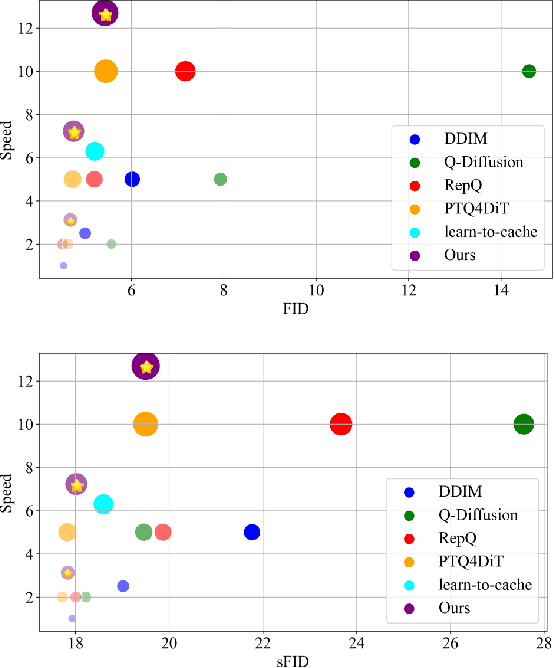
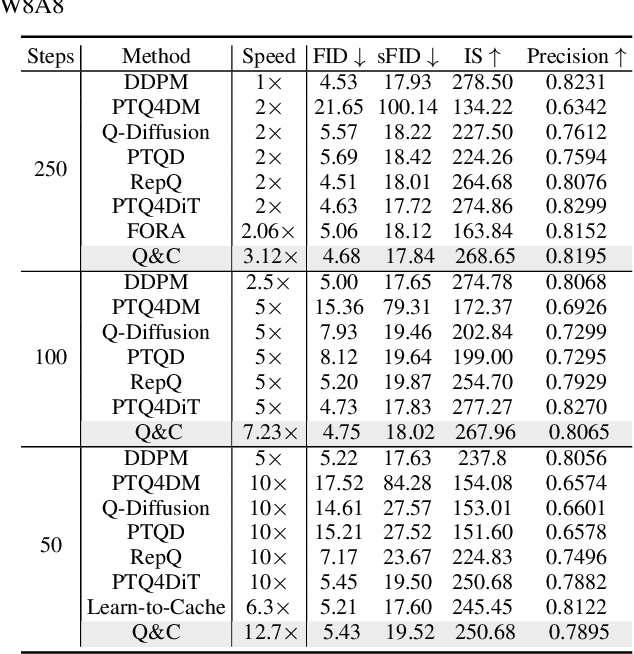
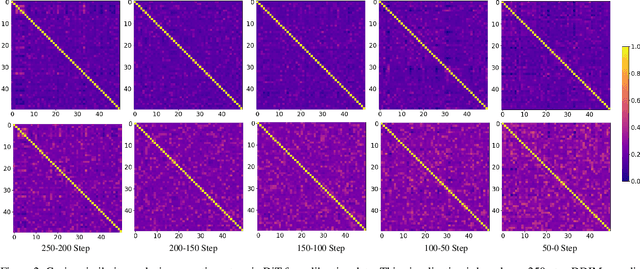
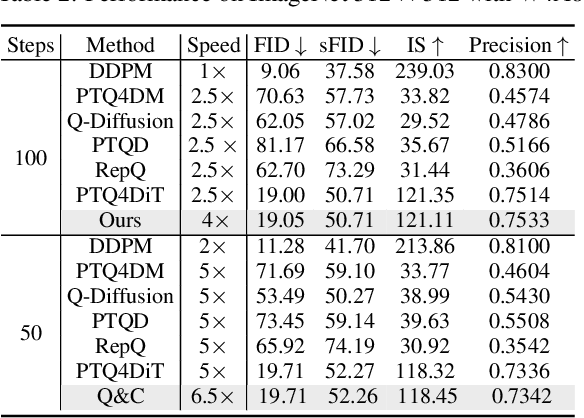
Abstract:Quantization and cache mechanisms are typically applied individually for efficient Diffusion Transformers (DiTs), each demonstrating notable potential for acceleration. However, the promoting effect of combining the two mechanisms on efficient generation remains under-explored. Through empirical investigation, we find that the combination of quantization and cache mechanisms for DiT is not straightforward, and two key challenges lead to severe catastrophic performance degradation: (i) the sample efficacy of calibration datasets in post-training quantization (PTQ) is significantly eliminated by cache operation; (ii) the combination of the above mechanisms introduces more severe exposure bias within sampling distribution, resulting in amplified error accumulation in the image generation process. In this work, we take advantage of these two acceleration mechanisms and propose a hybrid acceleration method by tackling the above challenges, aiming to further improve the efficiency of DiTs while maintaining excellent generation capability. Concretely, a temporal-aware parallel clustering (TAP) is designed to dynamically improve the sample selection efficacy for the calibration within PTQ for different diffusion steps. A variance compensation (VC) strategy is derived to correct the sampling distribution. It mitigates exposure bias through an adaptive correction factor generation. Extensive experiments have shown that our method has accelerated DiTs by 12.7x while preserving competitive generation capability. The code will be available at https://github.com/xinding-sys/Quant-Cache.
Hyper Adversarial Tuning for Boosting Adversarial Robustness of Pretrained Large Vision Models
Oct 08, 2024



Abstract:Large vision models have been found vulnerable to adversarial examples, emphasizing the need for enhancing their adversarial robustness. While adversarial training is an effective defense for deep convolutional models, it often faces scalability issues with large vision models due to high computational costs. Recent approaches propose robust fine-tuning methods, such as adversarial tuning of low-rank adaptation (LoRA) in large vision models, but they still struggle to match the accuracy of full parameter adversarial fine-tuning. The integration of various defense mechanisms offers a promising approach to enhancing the robustness of large vision models, yet this paradigm remains underexplored. To address this, we propose hyper adversarial tuning (HyperAT), which leverages shared defensive knowledge among different methods to improve model robustness efficiently and effectively simultaneously. Specifically, adversarial tuning of each defense method is formulated as a learning task, and a hypernetwork generates LoRA specific to this defense. Then, a random sampling and tuning strategy is proposed to extract and facilitate the defensive knowledge transfer between different defenses. Finally, diverse LoRAs are merged to enhance the adversarial robustness. Experiments on various datasets and model architectures demonstrate that HyperAT significantly enhances the adversarial robustness of pretrained large vision models without excessive computational overhead, establishing a new state-of-the-art benchmark.
HyperDet: Generalizable Detection of Synthesized Images by Generating and Merging A Mixture of Hyper LoRAs
Oct 08, 2024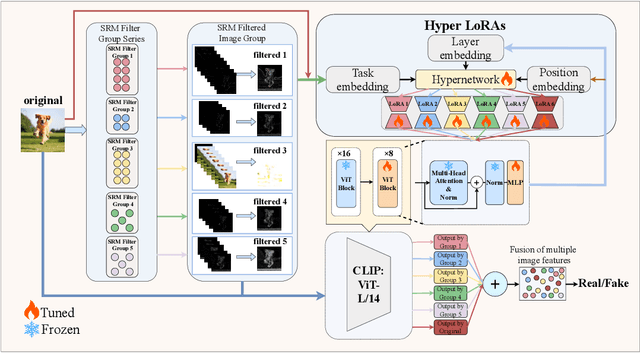



Abstract:The emergence of diverse generative vision models has recently enabled the synthesis of visually realistic images, underscoring the critical need for effectively detecting these generated images from real photos. Despite advances in this field, existing detection approaches often struggle to accurately identify synthesized images generated by different generative models. In this work, we introduce a novel and generalizable detection framework termed HyperDet, which innovatively captures and integrates shared knowledge from a collection of functionally distinct and lightweight expert detectors. HyperDet leverages a large pretrained vision model to extract general detection features while simultaneously capturing and enhancing task-specific features. To achieve this, HyperDet first groups SRM filters into five distinct groups to efficiently capture varying levels of pixel artifacts based on their different functionality and complexity. Then, HyperDet utilizes a hypernetwork to generate LoRA model weights with distinct embedding parameters. Finally, we merge the LoRA networks to form an efficient model ensemble. Also, we propose a novel objective function that balances the pixel and semantic artifacts effectively. Extensive experiments on the UnivFD and Fake2M datasets demonstrate the effectiveness of our approach, achieving state-of-the-art performance. Moreover, our work paves a new way to establish generalizable domain-specific fake image detectors based on pretrained large vision models.
CCDM: Continuous Conditional Diffusion Models for Image Generation
May 06, 2024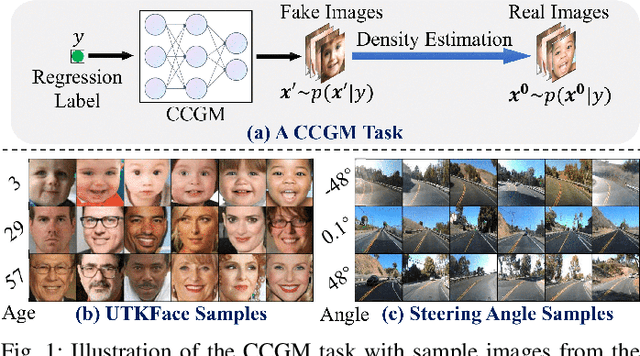
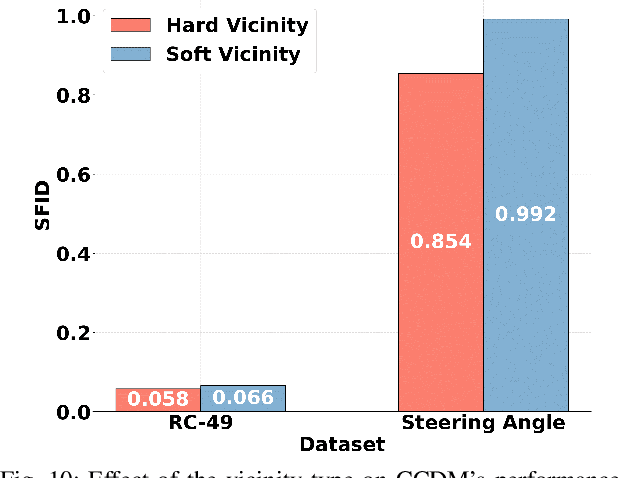
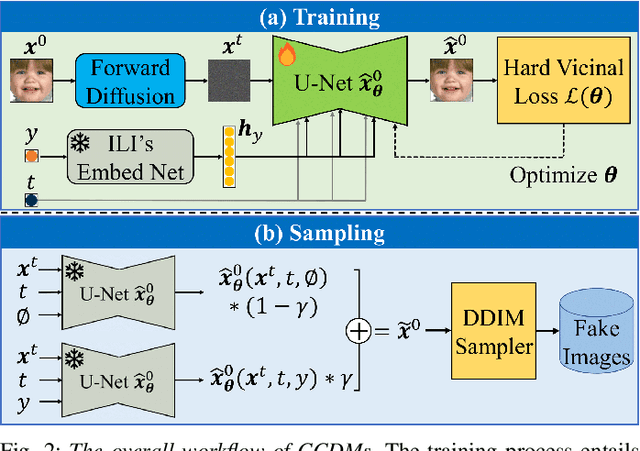
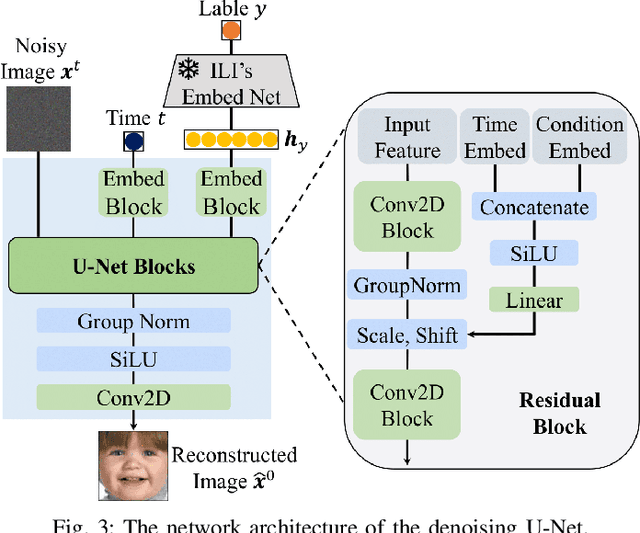
Abstract:Continuous Conditional Generative Modeling (CCGM) aims to estimate the distribution of high-dimensional data, typically images, conditioned on scalar continuous variables known as regression labels. While Continuous conditional Generative Adversarial Networks (CcGANs) were initially designed for this task, their adversarial training mechanism remains vulnerable to extremely sparse or imbalanced data, resulting in suboptimal outcomes. To enhance the quality of generated images, a promising alternative is to replace CcGANs with Conditional Diffusion Models (CDMs), renowned for their stable training process and ability to produce more realistic images. However, existing CDMs encounter challenges when applied to CCGM tasks due to several limitations such as inadequate U-Net architectures and deficient model fitting mechanisms for handling regression labels. In this paper, we introduce Continuous Conditional Diffusion Models (CCDMs), the first CDM designed specifically for the CCGM task. CCDMs address the limitations of existing CDMs by introducing specially designed conditional diffusion processes, a modified denoising U-Net with a custom-made conditioning mechanism, a novel hard vicinal loss for model fitting, and an efficient conditional sampling procedure. With comprehensive experiments on four datasets with varying resolutions ranging from 64x64 to 192x192, we demonstrate the superiority of the proposed CCDM over state-of-the-art CCGM models, establishing new benchmarks in CCGM. Extensive ablation studies validate the model design and implementation configuration of the proposed CCDM. Our code is publicly available at https://github.com/UBCDingXin/CCDM.
Driving Style Alignment for LLM-powered Driver Agent
Mar 17, 2024Abstract:Recently, LLM-powered driver agents have demonstrated considerable potential in the field of autonomous driving, showcasing human-like reasoning and decision-making abilities.However, current research on aligning driver agent behaviors with human driving styles remains limited, partly due to the scarcity of high-quality natural language data from human driving behaviors.To address this research gap, we propose a multi-alignment framework designed to align driver agents with human driving styles through demonstrations and feedback. Notably, we construct a natural language dataset of human driver behaviors through naturalistic driving experiments and post-driving interviews, offering high-quality human demonstrations for LLM alignment. The framework's effectiveness is validated through simulation experiments in the CARLA urban traffic simulator and further corroborated by human evaluations. Our research offers valuable insights into designing driving agents with diverse driving styles.The implementation of the framework and details of the dataset can be found at the link.
CBQ: Cross-Block Quantization for Large Language Models
Dec 13, 2023



Abstract:Post-training quantization (PTQ) has driven attention to producing efficient large language models (LLMs) with ultra-low costs. Since hand-craft quantization parameters lead to low performance in low-bit quantization, recent methods optimize the quantization parameters through block-wise reconstruction between the floating-point and quantized models. However, these methods suffer from two challenges: accumulated errors from independent one-by-one block quantization and reconstruction difficulties from extreme weight and activation outliers. To address these two challenges, we propose CBQ, a cross-block reconstruction-based PTQ method for LLMs. To reduce error accumulation, we introduce a cross-block dependency with the aid of a homologous reconstruction scheme to build the long-range dependency between adjacent multi-blocks with overlapping. To reduce reconstruction difficulty, we design a coarse-to-fine pre-processing (CFP) to truncate weight outliers and dynamically scale activation outliers before optimization, and an adaptive rounding scheme, called LoRA-Rounding, with two low-rank learnable matrixes to further rectify weight quantization errors. Extensive experiments demonstrate that: (1) CBQ pushes both activation and weight quantization to low-bit settings W4A4, W4A8, and W2A16. (2) CBQ achieves better performance than the existing state-of-the-art methods on various LLMs and benchmark datasets.
Turning Waste into Wealth: Leveraging Low-Quality Samples for Enhancing Continuous Conditional Generative Adversarial Networks
Aug 20, 2023Abstract:Continuous Conditional Generative Adversarial Networks (CcGANs) enable generative modeling conditional on continuous scalar variables (termed regression labels). However, they can produce subpar fake images due to limited training data. Although Negative Data Augmentation (NDA) effectively enhances unconditional and class-conditional GANs by introducing anomalies into real training images, guiding the GANs away from low-quality outputs, its impact on CcGANs is limited, as it fails to replicate negative samples that may occur during the CcGAN sampling. We present a novel NDA approach called Dual-NDA specifically tailored for CcGANs to address this problem. Dual-NDA employs two types of negative samples: visually unrealistic images generated from a pre-trained CcGAN and label-inconsistent images created by manipulating real images' labels. Leveraging these negative samples, we introduce a novel discriminator objective alongside a modified CcGAN training algorithm. Empirical analysis on UTKFace and Steering Angle reveals that Dual-NDA consistently enhances the visual fidelity and label consistency of fake images generated by CcGANs, exhibiting a substantial performance gain over the vanilla NDA. Moreover, by applying Dual-NDA, CcGANs demonstrate a remarkable advancement beyond the capabilities of state-of-the-art conditional GANs and diffusion models, establishing a new pinnacle of performance.
 Add to Chrome
Add to Chrome Add to Firefox
Add to Firefox Add to Edge
Add to Edge